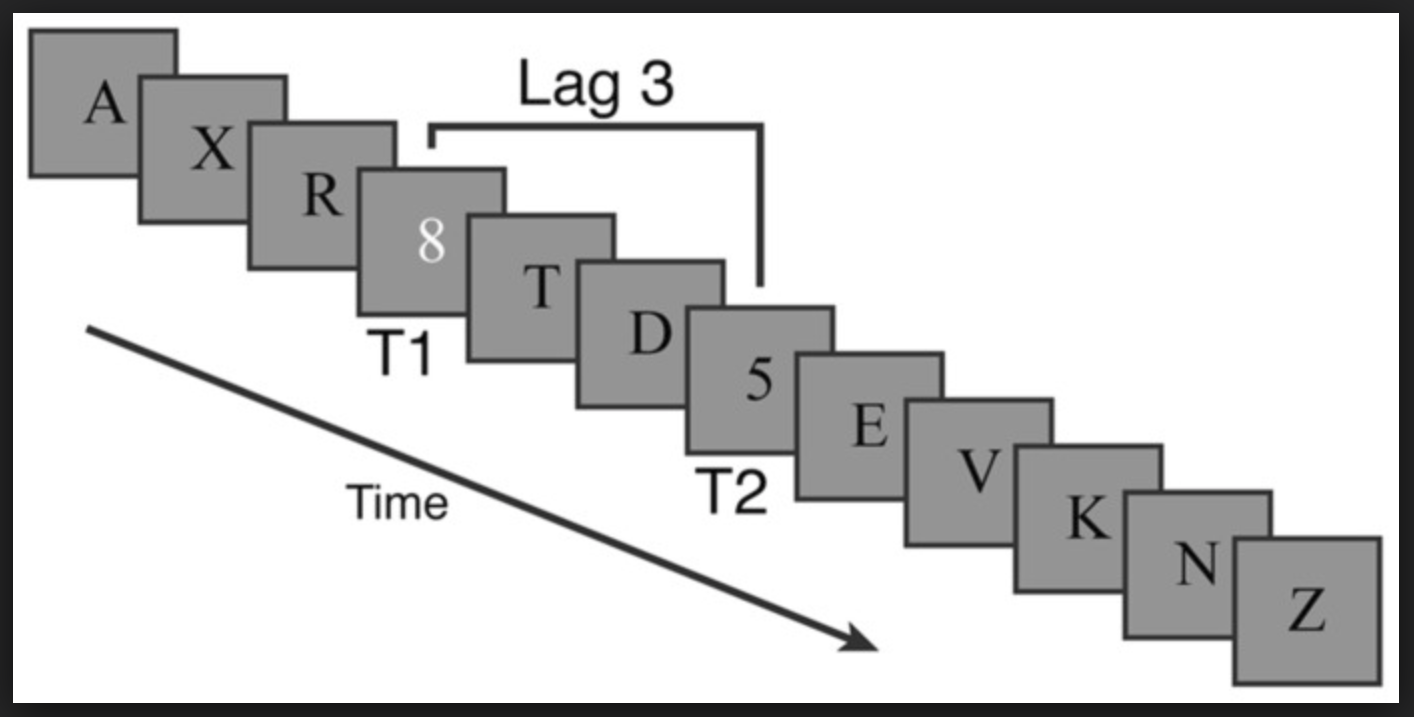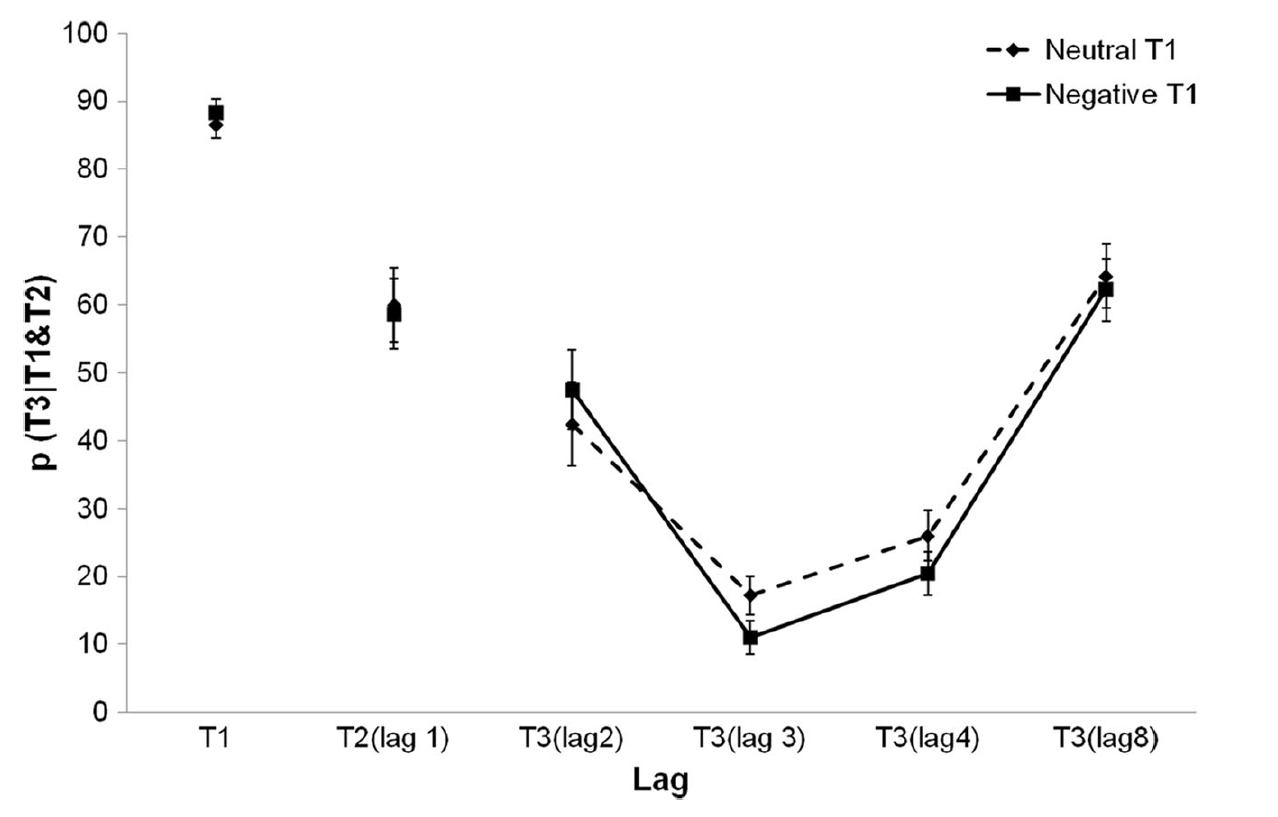Roadie folklore has it that there are some towns in rural Texas or Saskatchewan that are so small, you miss them if you blink too long while cruising down some highway to nowhere. This is unlikely to be actually true, although figuratively speaking, I can think of a few rural towns in Western Australia that qualify for “blink and you miss it status”.
But it’s not just towns that we might miss when we blink. In the laboratory of attention researchers, there has been much emphasis on a phenomenon known as the “attentional blink”. Unlike physical blinks, the attentional blink involves people with wide-open eyes who are tasked to keep track of two targets (call them T1 and T2) in a rapidly-presented visual stream.
The figure below shows a typical sequence of stimuli in a situation in which people must report any occurrence of “8” and also of “5”.

The pervasive finding is that if T2 occurs within 200-500 ms of T1, detection of T2 is impaired relative to when it occurs later (i.e., more than ½ second after T1). This impairment constitutes the attentional blink. Intriguingly, if T2 immediately follows T1, as the immediate next stimulus, it is reported with undiminished accuracy. This is referred to as “lag-1 sparing” and has been explained by assuming that when T1 and T2 occur in immediate succession, they share an “attentional episode.” (Perhaps this is why you cannot miss Hoboken, like it or not, when traveling from central Manhattan to points further south.)
If T2 occurs a little later, then it may fall into a window of consolidation of T1 (i.e., ongoing processing of the target even though attention has moved on), and because consolidation occupies attentional resources, T2 cannot gain access to attention and hence is often missed. (Ever heard of Carteret, NJ?)
A further intriguing attribute of the attentional blink is that the lag-1 sparing can be extended to other lags in some circumstances. That is, a second (or indeed third) target may be detected even at later lags under certain circumstances, thus delaying (or reducing) the attentional blink.
A recent article in the Psychonomic Society’s journal Attention, Perception, & Psychophysics explored the mechanisms underlying this spreading of sparing to positions beyond lag 1. Researchers Manuel Petrucci and Anna Pecchinenda departed from the observation in the literature that performance on T1 is better when it is an emotional stimulus—such as an emotional word or face—than when it is neutral.  An emotional T1 also magnifies the attentional blink by further reducing detection performance on T2. Conversely, if T2 is itself an emotional stimulus, the attentional blink is reduced. Both of these findings are readily explained within a “limited-resource” account on which an emotional word attracts additional attention that is then unavailable for processing elsewhere.
An emotional T1 also magnifies the attentional blink by further reducing detection performance on T2. Conversely, if T2 is itself an emotional stimulus, the attentional blink is reduced. Both of these findings are readily explained within a “limited-resource” account on which an emotional word attracts additional attention that is then unavailable for processing elsewhere.
Petrucci and Pecchinenda contrasted this limited-resource account to an alternative explanation based on the possibility that multiple targets might be grouped together into the same attentional episode. Those alternatives are best explained by considering their procedure, as shown in the figure below:
The figure shows a sequence of words, three of which are identified as targets by their color (white rather than black). Each word is shown briefly (just over 1/10th of a second), and the participants’ task was to report the three white targets at the end of the stream. Petrucci and Pecchinenda manipulated the emotional valence of T1, which was either neutral or negative, as in the figure above (“morte” means “death”).
On the resource account, processing of a negatively-valenced T1 should consume additional attention that boosts T1 performance but to the detriment of both T2 and T3. By contrast, if resource-limitations are not the driving factor underlying the attentional blink, then the fact that all three targets are identified by the same color might enable them to be subsumed within the same attentional episode, thus sparing them from the attentional blink. Indeed, performance on T2 and T3 might even be enhanced on this account if T1 is an emotional word because it leads to particularly vigorous processing of the attentional episode.
The results confirmed that the negatively-valenced T1 was detected with significantly greater accuracy than the neutral T1, although the difference was slight (88.3% vs. 86.5%). This confirms that the valence manipulation was successful and it is what would be expected under either account.
The more intriguing outcome is shown in the next figure which plots performance on T3 conditional on correct report of T1 and T2.

The figure permits several interesting insights. First, when three target-words are presented in rapid succession in a stream, the third target (T3) is partially spared from the attentional blink. That is, when T3 followed immediately after T2 (“lag 2” in the figure), performance is better than when T3 is delayed further (lags 3 and 4). It is only when T3 is delayed considerably (lag 8) that performance recovers from the attentional blink.
Second, this pattern is accentuated if T1 is an emotionally-negative item. That is, when T1 is negative (solid lines in the figure), spread of the sparing to T3 is greater than if T1 is neutral (dashed lines) and the magnitude of the attentional blink if T3 follows at longer lags is also greater.
The fact that T3 sparing increases with a negatively-valenced T1 suggests that greater resource allocation to emotional targets cannot be the sole explanation for the observed pattern. If resource allocation had been responsible, then performance should have been worse following an emotional T1, and in fact the opposite was observed. Instead, it appears that the emotion-enhanced benefit for T1 also benefited two additional targets when presented in immediate succession such that they became part of the same attentional episode.
In a nutshell, the attentional blink cannot be avoided, but enhanced attention to an initial target permits the inclusion of other stimuli into a single episode that can be spared from the blink.
Psychonomics article featured in this blogpost:
Petrucci, M., & Pecchinenda, A. (2018). Sparing and impairing: Emotion modulation of the attentional blink and the spread of sparing in a 3-target RSVP task. Attention, Perception, & Psychophysics, 80, 439-452. DOI: 10.3758/s13414-017-1470-y.
